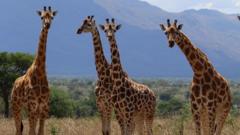Giraffes are renowned for their towering presence and unique patterns, but recent discoveries have added complexity to our understanding of these magnificent mammals. The International Union for Conservation of Nature (IUCN) now recognizes three new species of giraffe, totaling four distinct varieties across Africa.
This classification stems from extensive scrutiny of genetic diversity, comparing skulls and head shapes across different giraffes. Researchers assessed geographical features like rivers and mountains that may have caused these animals to evolve in isolation, giving rise to notable differences.
Say hello to the Southern giraffe, which roams areas including South Africa and Namibia, separated from its cousins by major rivers and rainforests. Next, there's the Reticulated giraffe, known for inhabiting the savannas of Kenya and Somalia, having evolved separately due to geographical barriers like the Tana river and mountainous terrains.
The Northern giraffe can be found in places like Uganda and South Sudan, with migration patterns also influencing its distinct genetic traits. Finally, the Masai giraffe, recognized by its stunning leaf-patterned coat, shares territories primarily in Kenya and Tanzania, but is kept apart from the Northern giraffe by the Nile River.
This new classification is pivotal for conservation, as it allows researchers to tailor strategies better suited to protect each species. Michael Brown from IUCN emphasizes the importance of understanding these genetic differences, highlighting that the overarching giraffe population displays vulnerability to extinction despite some sub-species being on the rise.
This innovative assessment aims not only to spotlight the enchanting variety of giraffes but also underscores the critical importance of conservation efforts for these remarkable animals.























